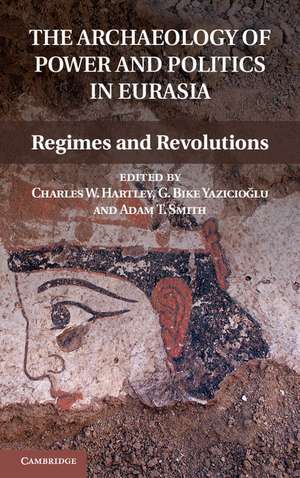The Archaeology of Power and Politics in Eurasia: Regimes and Revolutions
Editat de Charles W. Hartley, G. Bike Yazicioğlu, Adam T. Smithen Limba Engleză Hardback – 18 noi 2012
Preț: 550.89 lei
Preț vechi: 683.57 lei
-19% Nou
Puncte Express: 826
Preț estimativ în valută:
105.41€ • 110.35$ • 87.22£
105.41€ • 110.35$ • 87.22£
Carte indisponibilă temporar
Doresc să fiu notificat când acest titlu va fi disponibil:
Se trimite...
Preluare comenzi: 021 569.72.76
Specificații
ISBN-13: 9781107016521
ISBN-10: 1107016525
Pagini: 486
Ilustrații: 65 b/w illus. 7 maps 11 tables
Dimensiuni: 158 x 235 x 30 mm
Greutate: 0.73 kg
Ediția:New.
Editura: Cambridge University Press
Colecția Cambridge University Press
Locul publicării:New York, United States
ISBN-10: 1107016525
Pagini: 486
Ilustrații: 65 b/w illus. 7 maps 11 tables
Dimensiuni: 158 x 235 x 30 mm
Greutate: 0.73 kg
Ediția:New.
Editura: Cambridge University Press
Colecția Cambridge University Press
Locul publicării:New York, United States
Cuprins
Introduction: regimes, revolutions, and the materiality of power in Eurasian archaeology Charles W. Hartley, G. Bike Yazıcıoğlu and Adam T. Smith; Part I. The Rhetoric of Regime and Ideology of Revolution: 1. Archaeology and the national idea in Eurasia Victor A. Shnirelman; 2. National history and identity narratives in China and cultural heritage interpretation in Xinjiang Gwen P. Bennett; 3. 'Yerevan, my ancient Erebuni': archaeological repertoires, public assemblages, and the manufacture of a (post-)Soviet nation Adam T. Smith; 4. Violence and power visualized: representations of military engagements between Central Asia and the Achaemenid Persian Empire Wu Xin; 5. Public vs. private: perspectives on the communication of power in ancient Chroasmia Fiona Kidd, Michelle Negus Cleary and Elizabeth Baker Brite; 6. Lines of power: equality or hierarchy among the Iron Age agro-pastoralists of southeastern Kazakhstan Claudia Chang; Part II. Materialities of Homeland, Practices of Expansion: 7. Homelands in the present and in the past: political implications of a dangerous concept Philip Kohl; 8. Processes and practices of death: toward a bioarchaeology of dynamic societies Maureen Marshall; 9. Ritualization of weapons in a contact zone: between the past and the present Kathryn M. Linduff and Yang Jianhua; 10. Ethos, materiality, and paradigms of political action in early medieval communities of the northwestern Caspian region Irina Lita Shingiray; 11. Legitimacy and control: the making of the imperial Liao heartland Hu Ling; 12. A bioarchaeological study of Xiongnu expansion in Iron Age Tuva, South Siberia Eileen M. Murphy; Part III. Regimes of the Body, Revolutions of Value: 13. Kazakhstan, post-socialist transition, and the problem of multiple materialities Victor Buchli; 14. Forging social networks: metallurgy and the politics of value in Bronze Age Eurasia David L. Peterson; 15. Where pottery and politics meet: mundane objects and complex political life in the Late Bronze Age South Caucasus Alan Greene; 16. Forming techniques and Kura-Araxes period pottery in the Eastern Caucasus MaryFran Heinsch; 17. Beastly goods: pastoral production in the Late Bronze Age Tsaghkahovit Plain Belinda H. Monahan; 18. From regimes to revolutions: technology and technique at the Bronze Age tell at Százhalombatta, Hungary Joanna Sofaer; Conclusion: on archaeology and politics across Eurasia Geoff Emberling.
Descriere
This book brings together archaeological investigations of Eurasian regimes and revolutions ranging from the Bronze Age to the modern day.
